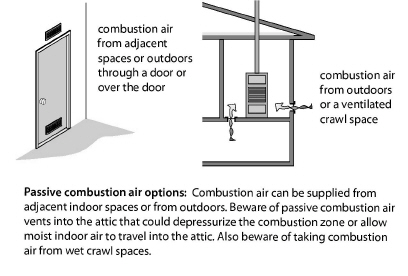
|
SWS Detail: 2.0203.1 Combustion Air for Natural Draft Appliances |
A combustion appliance zone (CAZ) is classified as either an un-confined space or confined space. An un-confined space is a CAZ having the NFPA-required amount of room volume that is assumed to provide enough combustion air. A confined space is a CAZ with less than the NFPA-required amount of volume.
A confined space is defined by NFPA 54 as a room containing one or more combustion appliances that has less than 50 cubic feet of volume for every 1000 BTUH of appliance input.
For confined spaces, the NFPA 54 requires additional combustion air from outside the CAZ. Combustion air is supplied to the combustion appliance in four ways.
1. To an un-confined space through leaks in the building.
2. To a confined space through an intentional opening or openings between the CAZ and other indoor areas where air leaks replenish combustion air.
3. To a confined space through an intentional opening or openings between the CAZ and outdoors or ventilated intermediate zones like attics and crawl spaces.
4. Directly from the outdoors to the appliance. Appliances with direct combustion air supply are called sealed-combustion or direct vent appliances.
Important Note: The National Fuel Gas Code (NFPA 54 – 2009) presents two methods for calculating combustion air. The simplest of the two methods is discussed in this section. We discuss this method because mechanical inspectors often refer to it. However, neither method really predicts the amount of available combustion air.
The best way to evaluate the combustion air in an existing building with an existing combustion heating system is with an electronic combustion analysis. If the oxygen reading from the combustion analyzer is more than 5%, this oxygen (O2) measurement verifies that an adequate amount of combustion air is available. At 5% or more of flue-gas oxygen, additional combustion air is usually unnecessary.
8.12.1 Un-Confined-Space Combustion Air
Combustion appliances located in most basements, attics, and crawl spaces get adequate combustion air from leaks in the building shell. Even when a combustion appliance is located within the home’s living space, it gets adequate combustion air from air leaks, unless the house is airtight or the combustion zone is depressurized.
8.12.2 Confined-Space Combustion Air
A confined space is defined by NFPA 54 as a room containing one or more combustion appliances that has less than 50 cubic feet of volume for every 1000 BTUH of appliance input.
However, if a small mechanical room is connected to adjacent spaces through large air passages like floor-joist spaces, the CAZ may not need additional combustion air despite sheeted walls and a door separating the CAZ from other indoor spaces. You can measure the connection between the CAZ and other spaces by worst-case draft testing or blower door pressure testing.
When the home is unusually airtight (<0.20 ACHn), the CAZ may not have adequate combustion air, even when the combustion zone is larger than the minimum confined-space room volume.

Combustion Air from Outdoors
In confined spaces or airtight homes where combustion appliances need outdoor combustion air, NFPA 54 prefers a single vent opening installed as low in the CAZ as practical. A combustion air vent into an attic may depressurize the CAZ and deliver warm moist air from the CAZ into a cold attic. Instead, connect the combustion zone to a ventilated crawl space (if it’s dry) or directly to the outdoors through a single low vent if possible.
For the intake, choose an outdoor location that is sheltered from prevailing winds, but not in an inside corner. Don’t choose an exterior wall that is parallel to prevailing winds. Wind blowing parallel to the exterior wall or at a right angle to the vent opening de-pressurizes both the vent and the CAZ connected to it.
|
Location |
Dimensions |
|---|---|
|
Two direct openings to adjacent indoor space |
Minimum area each: 100 in2 1 in2 per 1000 BTUH each Combined room volumes must be ≥ 50 ft3/1000 BTUH |
|
Two direct openings or vertical ducts to outdoors |
Each vent should have 1 in2 for each 4000 BTUH |
|
Two horizontal ducts to outdoors |
Each vent should have 1 in2 for each 2000 BTUH |
|
Single direct or ducted vent to outdoors |
Single vent should have 1 in2 for each 3000 BTUH |
|
From the National Fuel Gas Code 2009 (NFPA 54) |
|
Net free area is smaller than actual vent area and takes the blocking effect of louvers and grilles into account. Metal grilles and louvers provide 60% to 80% of their area as net-free area while wood louvers provide only 20% to 25%. Combustion-air vents should be no less than 3 inches in their smallest dimension.
Example Combustion Air Calculation
Here is an example of one indoor space providing combustion air to another indoor space. The furnace and water heater are located in a confined space. The furnace has an input rating of 100,000 BTUH. The water heater has an input rating of 40,000 BTUH. Therefore, there should be 140 in2 of net free area of vent between the mechanical room and other rooms in the home.
([100,000 + 40,000] ÷ 1,000) = 140 x 1 in2 = 140 in2
Each vent should therefore have a minimum of 140 in2 net free area. If a metal grill covers 60% of the opening’s area, divide the 140 in2 by 0.60.
140 in2 / 0.6 = 233 in2